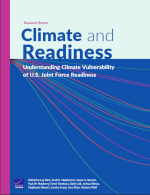Climate and Readiness: Understanding Climate Vulnerability of U.S. Joint Force Readiness

Type: Book / EBook
Description: The physical environment in which the U.S. Department of Defense (DoD) must operate is being affected by climate hazards, which adversely affect the performance of the joint force and the systems that support it. Generating, maintaining, and even increasing force readiness in light of changing climate threats is a key component of meeting high-level U.S. strategic goals, from defending the homeland to deterring aggression and strategic attacks. Acknowledging that climate effects are
likely to become more severe as global temperatures rise, the authors of this report discuss the results of an initial study they conducted to develop links between climate and readiness, laying the groundwork for the eventual integration of climate risk with quantitative readiness assessment and decision making to help ensure that military forces can reliably and affordably sustain needed readiness in a changing climate. A key contribution of the study is a climate readiness framework for understanding the risk to readiness that may result from a combination of (1) exposure to climate hazards, such as drought, flooding, wildfire, and tropical storms, and (2) the underlying vulnerability of readiness inputs — i.e., people, training, equipment, and force projection — to such hazard exposure.
Authors: Katharina Ley Best, Scott R. Stephenson, Susan A. Resetar, Paul W. Mayberry, Emmi Yonekura, Rahim Ali, Joshua Klimas, Stewart, Jessica Arana, Inez Khan, Vanessa Wolf
Publisher: RAND Corporation
Publication time and place: 2023, Santa Monica, California, USA
Pages: 122
Publication link: http://www.rand.org/t/RRA1551-1
TOPICS/Subjects:
- CLIMATE CHANGE
- Capacity Building
- DISASTER RESPONSE
- Civil Military Cooperation
- Best Practices
- CLIMATE AND SECURITY
- National Security
- International Security